When I first started connecting Shopify stores to WhatsApp, I realized one thing fast — customers don’t want to look for support. They want to message you, get help instantly, and move on with their day. In my experience, that’s exactly where a Shopify WhatsApp Support Chatbot built with LiveChatAI shines.
It’s like having a smart support teammate who never sleeps — one that knows your product catalog, your store policies, your order data, and even when to hand off to a human. The result? You deliver faster answers, cut repetitive tickets, and turn WhatsApp into a real conversion channel, not just a support inbox.
In this guide, I’ll walk you through exactly how I build these bots — step by step — using LiveChatAI’s native integrations with both Shopify and WhatsApp Business. We’ll go through every phase: setup, training, automation, human handoff, and testing. By the end, you’ll have a fully working AI chatbot on WhatsApp that can:
- 🧠 Understand and respond to product or policy questions instantly.
- 🛒 Connect directly to your Shopify store for live product, cart, and order data.
- 💬 Talk to customers naturally, just like a human support rep.
- 🔄 Hand off tricky cases seamlessly to your live team.
💡 What “Shopify-WhatsApp-Support-Chatbot” Actually Means
To me, this setup isn’t just a chatbot — it’s a hybrid customer assistant.
It works by combining three layers:
The AI that understands, retrieves, and responds
When these three sync correctly, you get a conversational flow that feels natural — customers can ask “Where’s my order?” or “Do you have this shirt in blue?” and get accurate, instant answers powered by your own Shopify data.
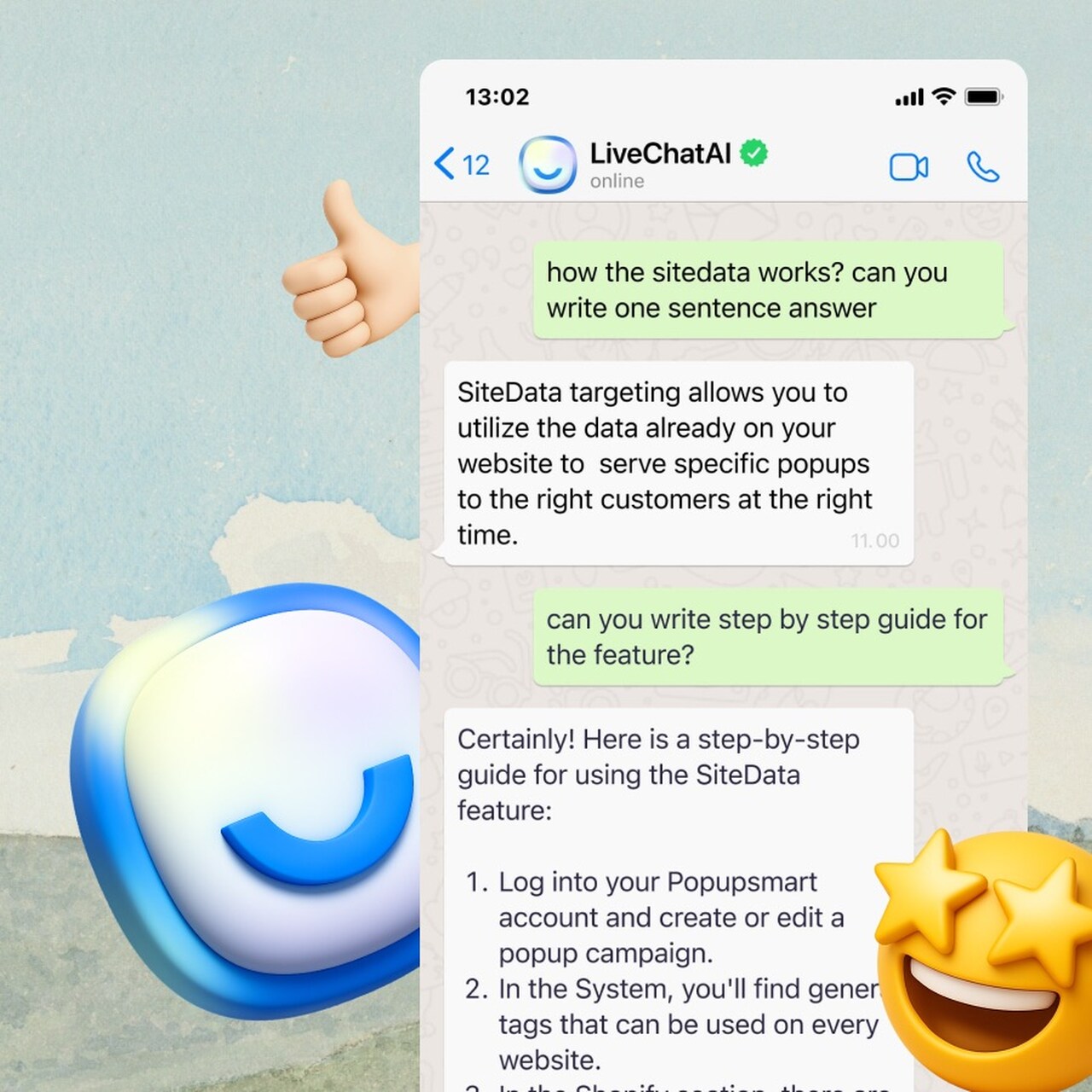
🎯 Who This Guide Is For
I wrote this guide for Shopify merchants and support teams who want to:
- Reduce repetitive questions (“Where’s my order?”, “What’s your return policy?”)
- Offer 24/7 support without scaling headcount
- Improve customer experiences in WhatsApp conversations
- Turn customer chats into purchase moments
Whether you’re a solo entrepreneur managing DMs manually or a support manager handling thousands of tickets a week, this setup can scale both ways.
🧠 Why I Believe This Integration Changes Support ROI
In my opinion, the ROI of WhatsApp chatbots in eCommerce isn’t just about automation — it’s about customer proximity.
The combination — speed + channel familiarity — means faster conversions and happier customers. I’ve personally seen Shopify stores cut average response time from 2 hours to under 3 minutes once they connected LiveChatAI to WhatsApp.
🧩 Prerequisites & Accounts You’ll Need
Before jumping into the actual setup, let’s make sure you’ve got all the right tools, permissions, and verified accounts ready. From my experience, 90% of integration issues happen because one of these accounts isn’t connected or verified properly — so trust me, this step is worth double-checking.
🛍️Shopify Admin Access
To connect Shopify with LiveChatAI, you need:
- Admin or Owner permissions on your Shopify store.
- A store URL in the format yourstore.myshopify.com.
- Your store must have products and policies already added (LiveChatAI will use these as data sources).
You don’t need to install any extra Shopify apps — LiveChatAI connects directly through its AI Actions → Shopify module.
🤖LiveChatAI Account (AI Actions Access Required)
Head to LiveChatAI.com and sign up (or log in) to your dashboard.
Once you’re in:
- Go to the AI Actions tab — this is where you’ll find the Shopify integration card.
- You’ll also need access to the Embed & Integrate section to add WhatsApp later.
💡 Pro tip from me: If you’re part of a support or marketing team, ask your workspace admin to grant “Bot Editing” and “Integration” permissions — otherwise, you won’t see the Shopify and WhatsApp modules.
📲WhatsApp Business via Meta
You’ll need a verified WhatsApp Business account that’s linked to a Meta Business Manager.
Here’s the checklist I personally follow:
💬 Note: The number you link will appear to customers as your official business contact. You can use either a landline or mobile, but it can’t be tied to a personal WhatsApp account.
🔐Permissions & Verification Checklist
Before moving on, make sure you’ve ticked everything below ✅
💡 In my experience: Teams that complete all these verifications first rarely face connection errors later — while skipping even one can lead to Meta API rejections or bot reply failures.
How the Shopify-WhatsApp-LiveChatAI Flow Works
Before we dive into configuration, I want to share how I see the pieces connecting — from the user sending a WhatsApp message, all the way to action in Shopify. Understanding this flow helps you troubleshoot, design UX, and guard against edge cases.
Here’s how I conceptualize it:
🔄 Data Flow: Customer → WhatsApp → LiveChatAI → Shopify
In my setups, the flow usually looks like this:
- Customer sends a message on WhatsApp (e.g. “Do you have this dress in size M?”).
- WhatsApp channels it into LiveChatAI (via the WhatsApp Business integration).
- LiveChatAI’s NLP + intent detection figures out “product lookup” or “size question.”
- If the intent requires Shopify data, LiveChatAI triggers an AI Action (e.g. search_shop_catalog) over the Shopify integration.
- Shopify returns data (list of products, variants, inventory).
- LiveChatAI constructs a conversational response based on the returned data (e.g. “Yes — here are the items I found…”)
- The message is relayed back to user over WhatsApp.
- If needed, LiveChatAI can invoke other AI Actions (e.g. adding item to cart, checking policies) or escalate to a human.
That pipeline — from message to action to reply — is what makes the integration feel “real.” It’s not just canned responses; your bot becomes functionally aware of your store.
🧷 When AI Answers vs. When a Human Takes Over
In my experience, the real art is knowing when to let the bot answer and when to pass it off. Here’s how I manage that:
So I typically set a confidence threshold (for instance: < 70% confidence) for the bot. Below that, I route to an agent with the full chat context. This reduces the risk of frustrating mis-answers.
🔌 Which AI Actions Enable Shopify Data Retrieval
To make this whole flow work, you need certain AI Actions enabled in LiveChatAI. Based on LiveChatAI’s docs, here are the common ones I always include:
- search_shop_catalog — search products by keyword, filters (like color, price).
- get_product_details — fetch variant, stock, price, description.
- get_cart — show to user what’s currently in their cart.
- update_cart — add/remove items or change quantities.
- search_shop_policies_and_faqs — retrieve return policies, shipping details, FAQ content.
When you enable those, your bot can do real work, not just talk.
🚀 Step-by-Step — Connect Shopify to LiveChatAI
When I build these integrations for Shopify stores, I always start with Shopify → LiveChatAI connection, because that lets the chatbot “see” your store data — products, carts, and policies — in real time. Once this link works, the rest (like WhatsApp) becomes a simple layer on top.
🧭 Navigate to AI Actions → Shopify in LiveChatAI
- Log in to your LiveChatAI Dashboard → go to the AI Actions tab.
- You’ll see several ready-to-use integrations. Click the Shopify card.
- The setup window will open, prompting you to enter your Shopify store URL.
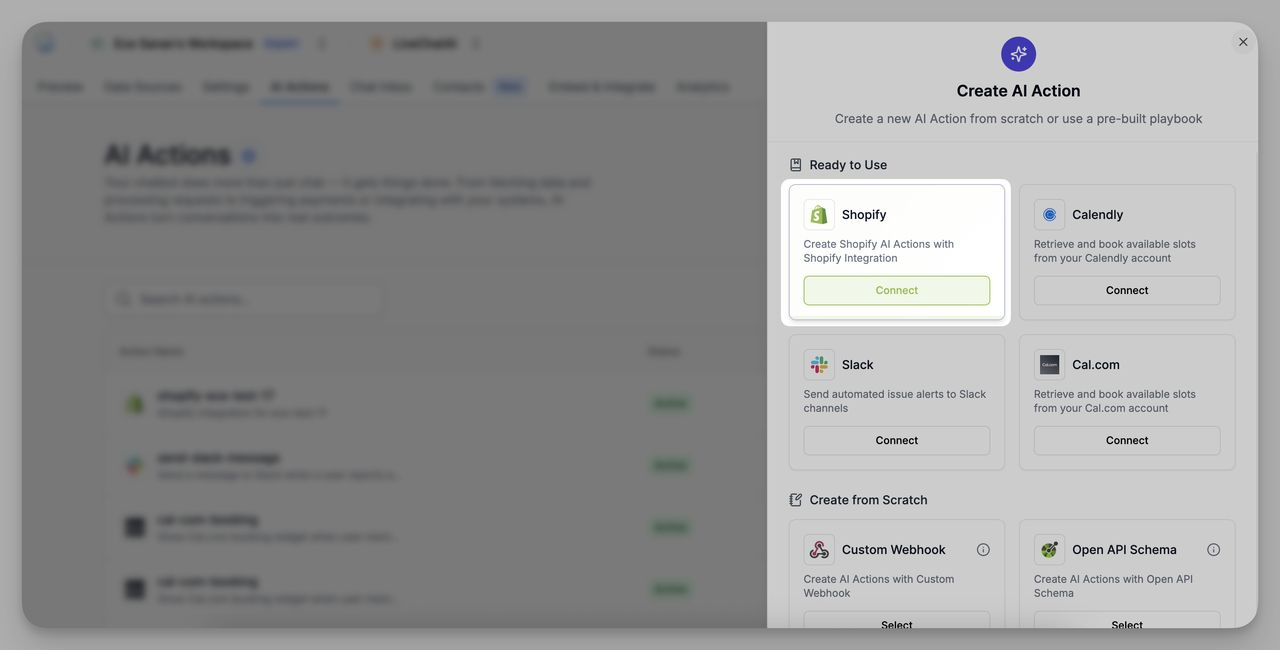
🔗Connect Your Shopify Store
- Type your Shopify store URL (e.g., yourstore.myshopify.com) and press Connect.
- You’ll be redirected to Shopify’s permission page — click Install app or Approve to authorize LiveChatAI.
- Once connected, you’ll see a confirmation like “Shopify successfully linked”.
💡 Tip: Keep your browser logged into the same Shopify Admin account during setup. If not, the connection might fail with a “permission denied” error.
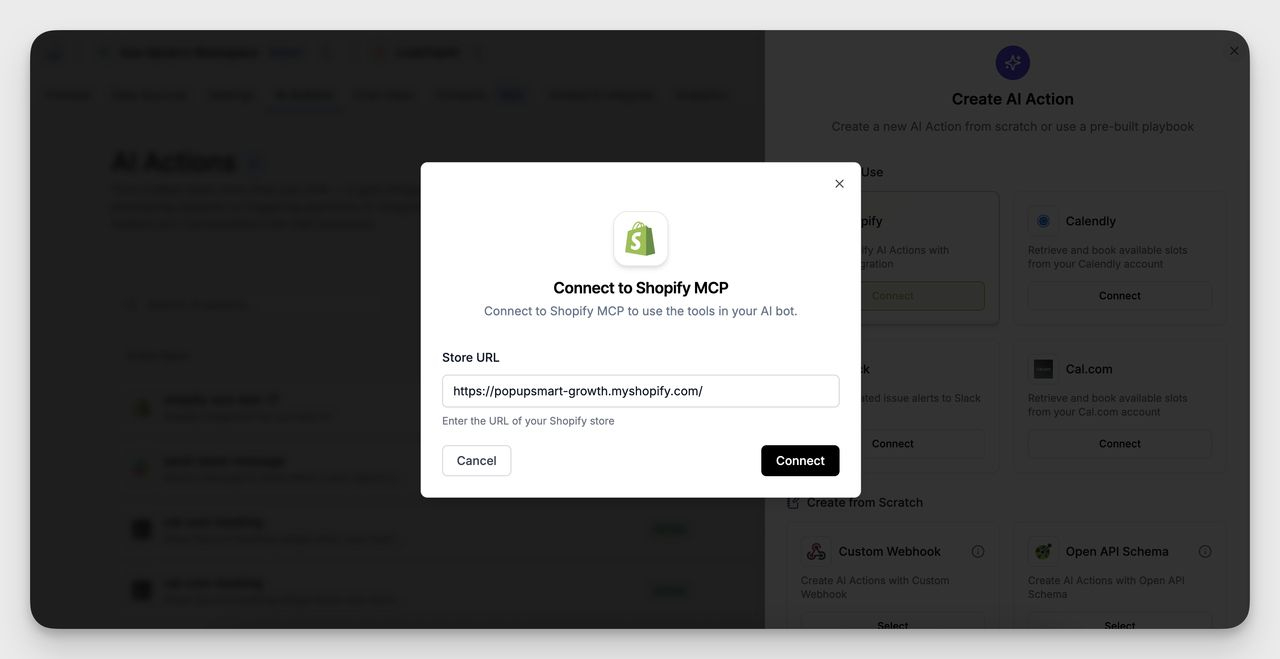
🧰Enable Key Tools for Support Automation
After connection, you’ll see a list of toggle switches for Shopify AI Actions.
Here’s what I recommend enabling (and why):
Once toggled on, these tools give your chatbot real-time access to Shopify data.
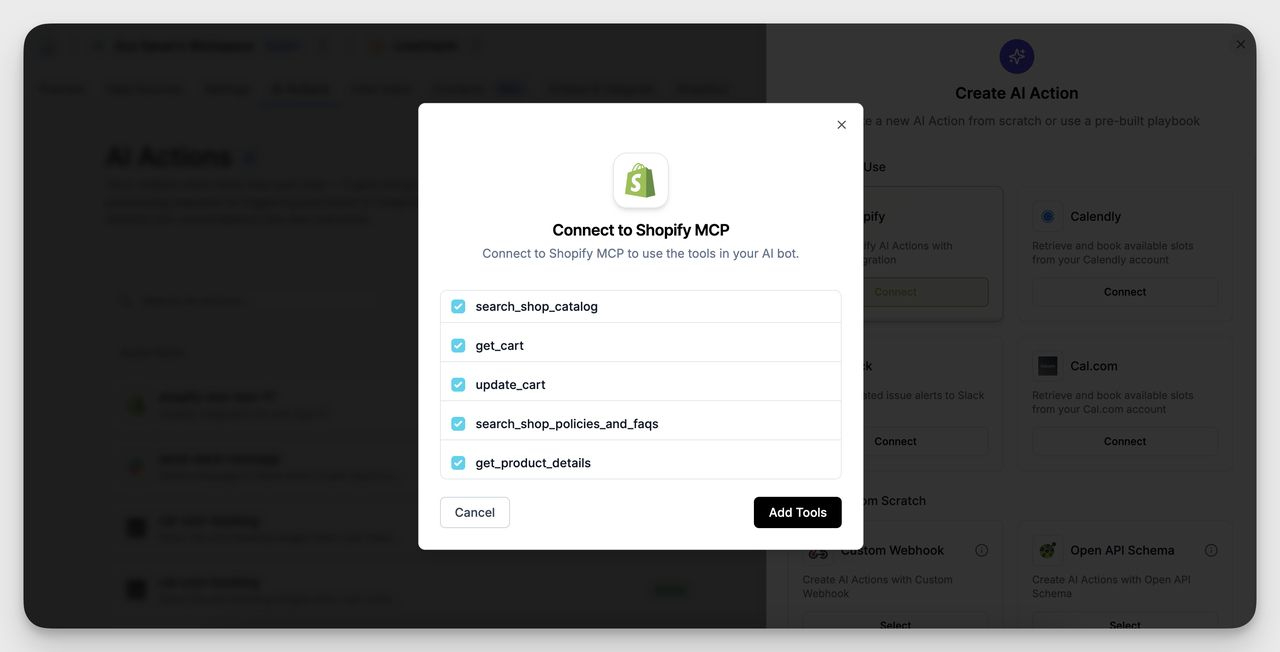
🧪Test Basic Queries
I always test right away using the LiveChatAI preview chat:
Try messages like:
- “Show me hoodies under $50.”
- “What’s your shipping policy?”
- “Add the blue T-shirt to my cart.”
If the bot responds correctly, the integration is live and pulling real Shopify data.
💬 In my experience: This entire step takes 5–10 minutes, but it’s what transforms your chatbot from static FAQ to AI shopping assistant. Once this works, you’re ready to plug it into WhatsApp.
💬 Step-by-Step — Integrate LiveChatAI with WhatsApp
Once Shopify is connected, the next step is to bring your AI chatbot to life where your customers already spend their time — WhatsApp.
I’ve personally found this to be the most exciting part because it’s where your automation meets your customers. The setup through LiveChatAI’s interface is smooth and takes less than 15 minutes if you already have a verified WhatsApp Business account under Meta.
🧭Go to Embed & Integrate → WhatsApp Integration
- Inside your LiveChatAI Dashboard, click on the Embed & Integrate tab.
- From the list of channels (Website, WhatsApp, Messenger, etc.), choose WhatsApp.
- Click Connect WhatsApp Account.
💡 Tip: If your account doesn’t show this option, ask your workspace admin to grant “Integration Access” under permissions.
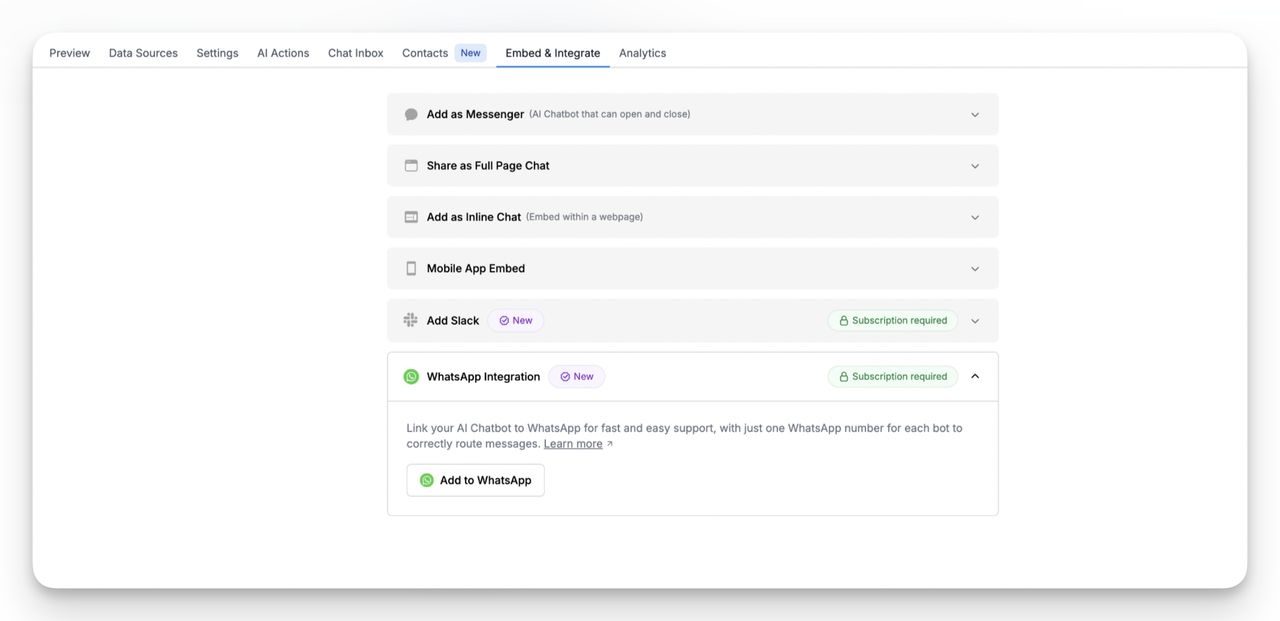
🔐Log in with Meta Business & Grant Permissions
After clicking Connect, you’ll be redirected to the Meta Business login page:
- Log into your Meta Business Manager using the same credentials tied to your WhatsApp Business Account.
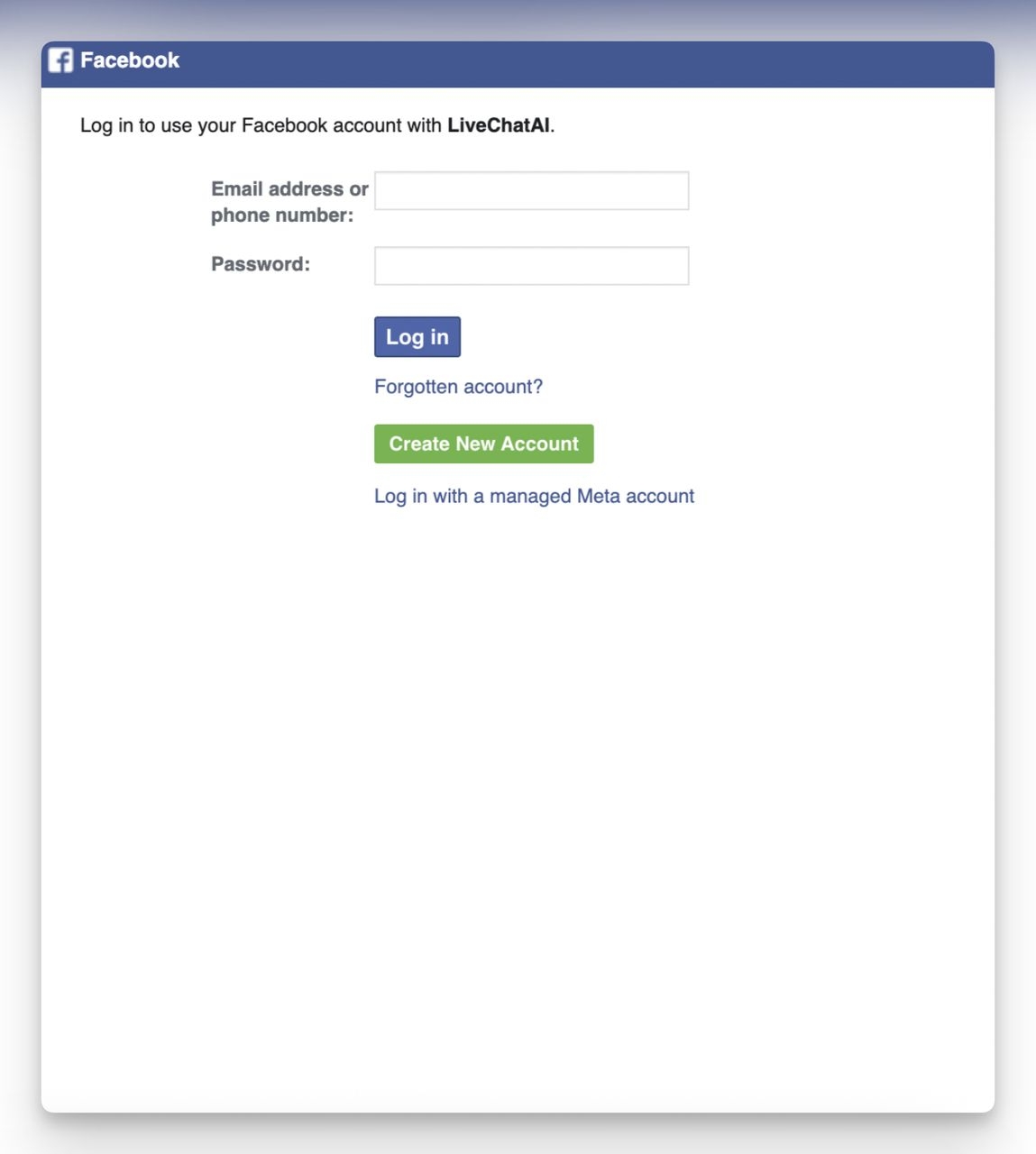
- Approve all requested permissions — LiveChatAI needs access to your WhatsApp Business number, messaging templates, and webhook events to route messages correctly.
3. Select your WhatsApp Business Account from the dropdown list.
Once permissions are granted, you’ll return automatically to LiveChatAI with a confirmation prompt.
☎️ Add & Verify Your WhatsApp Business Number
- Click Add Number and enter the WhatsApp Business number you want to connect.
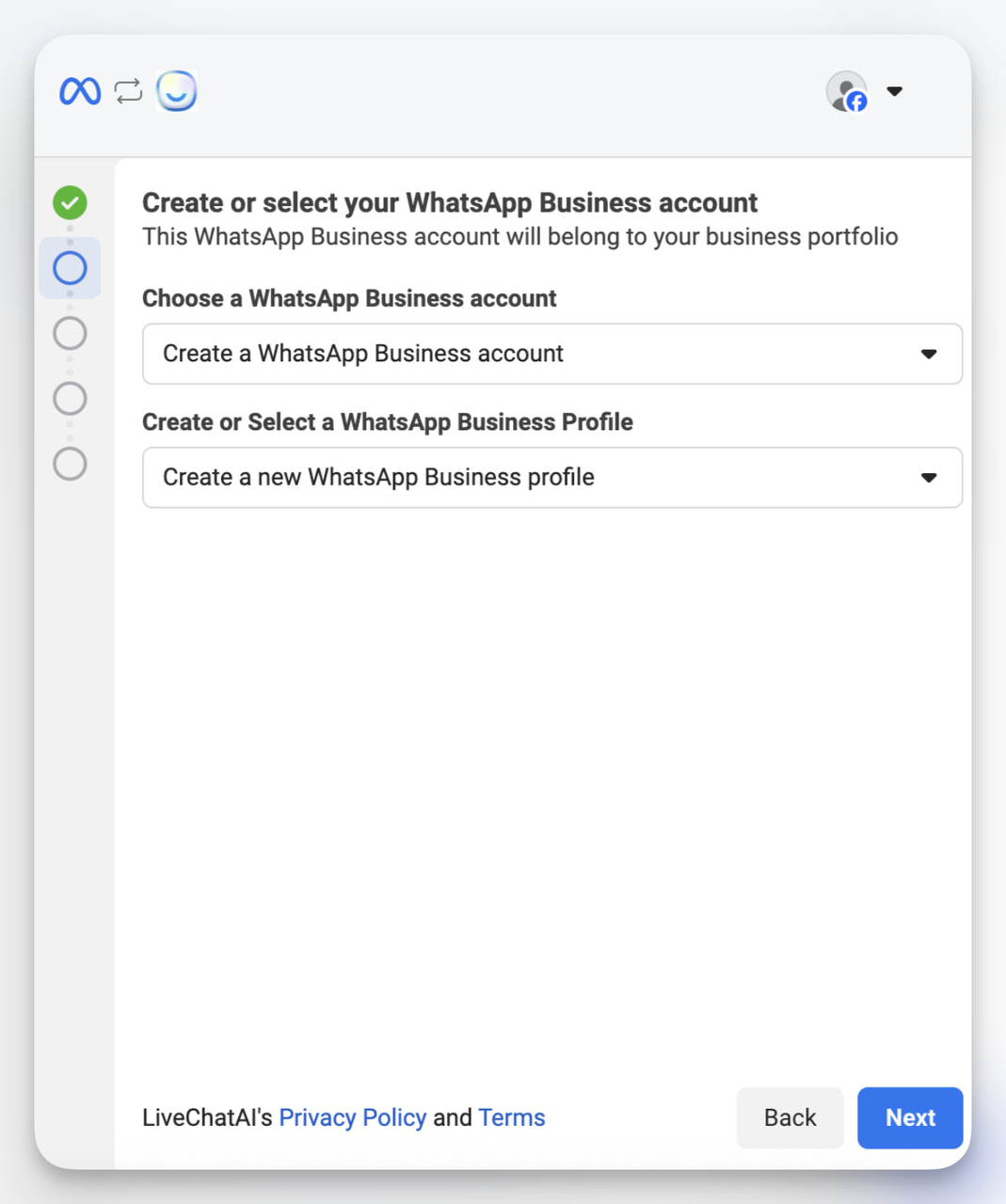
- Choose your verification method (SMS or call).
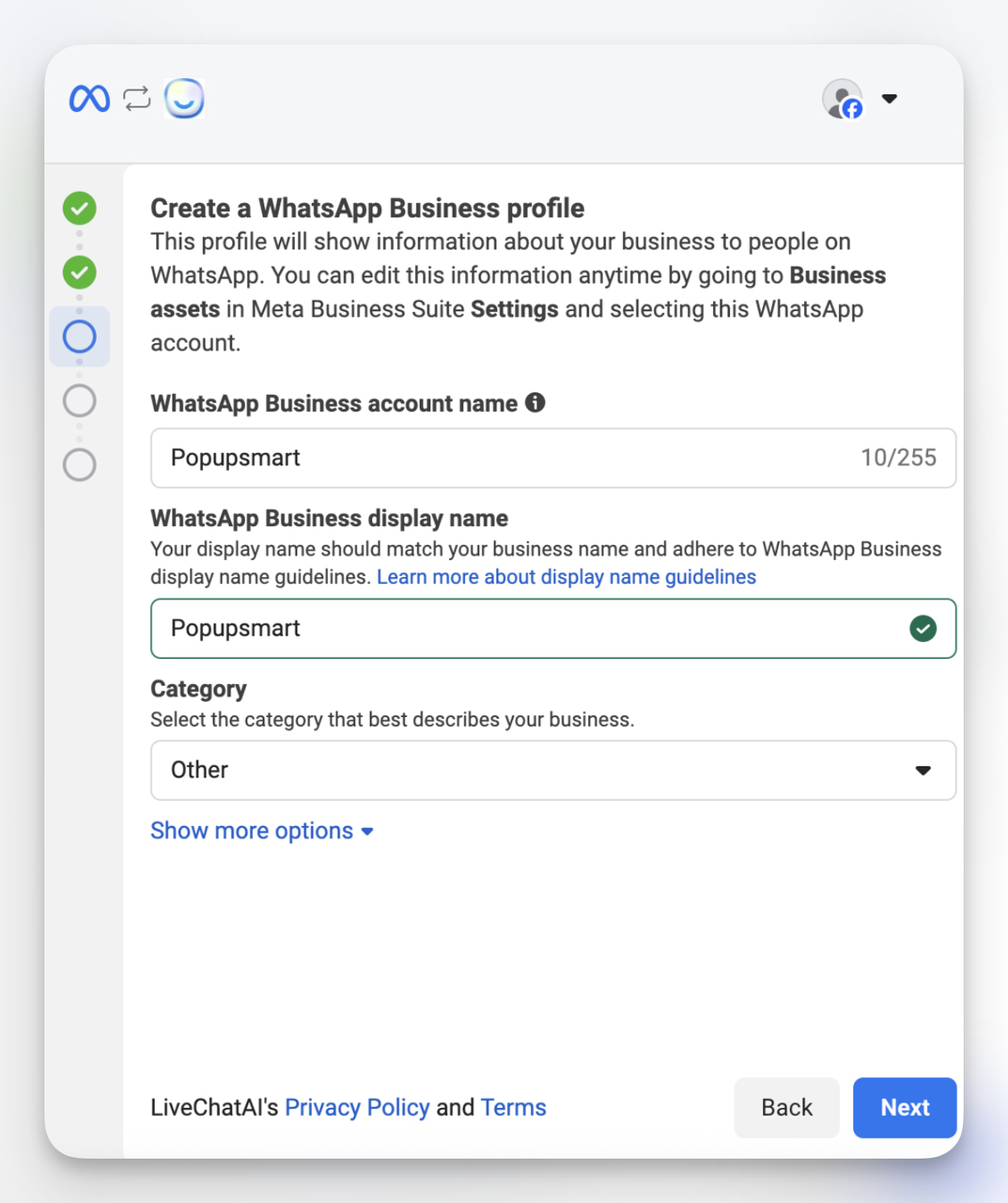
- Enter the 6-digit verification code received on that number.
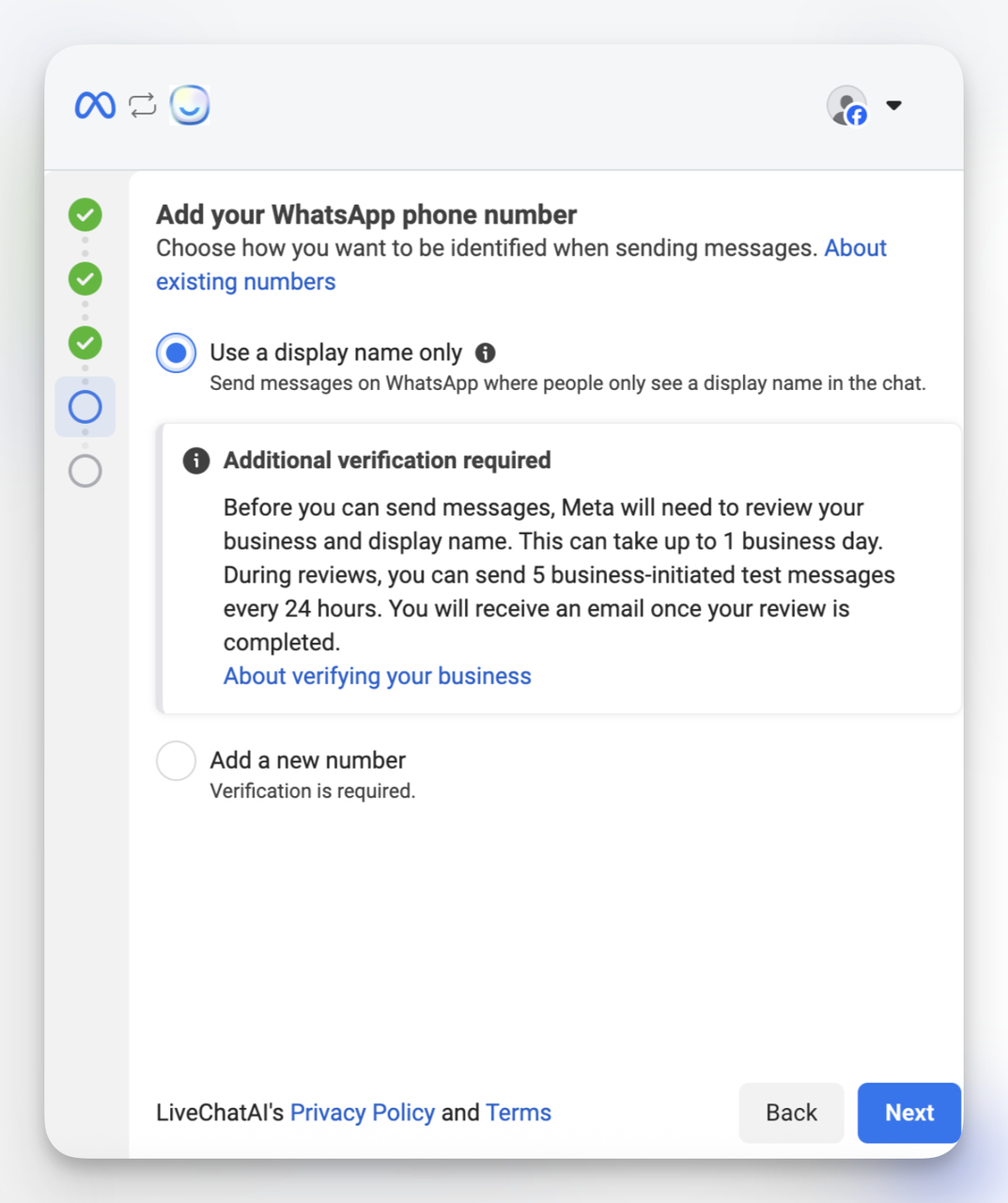
- Once verified, your number appears with a green checkmark.
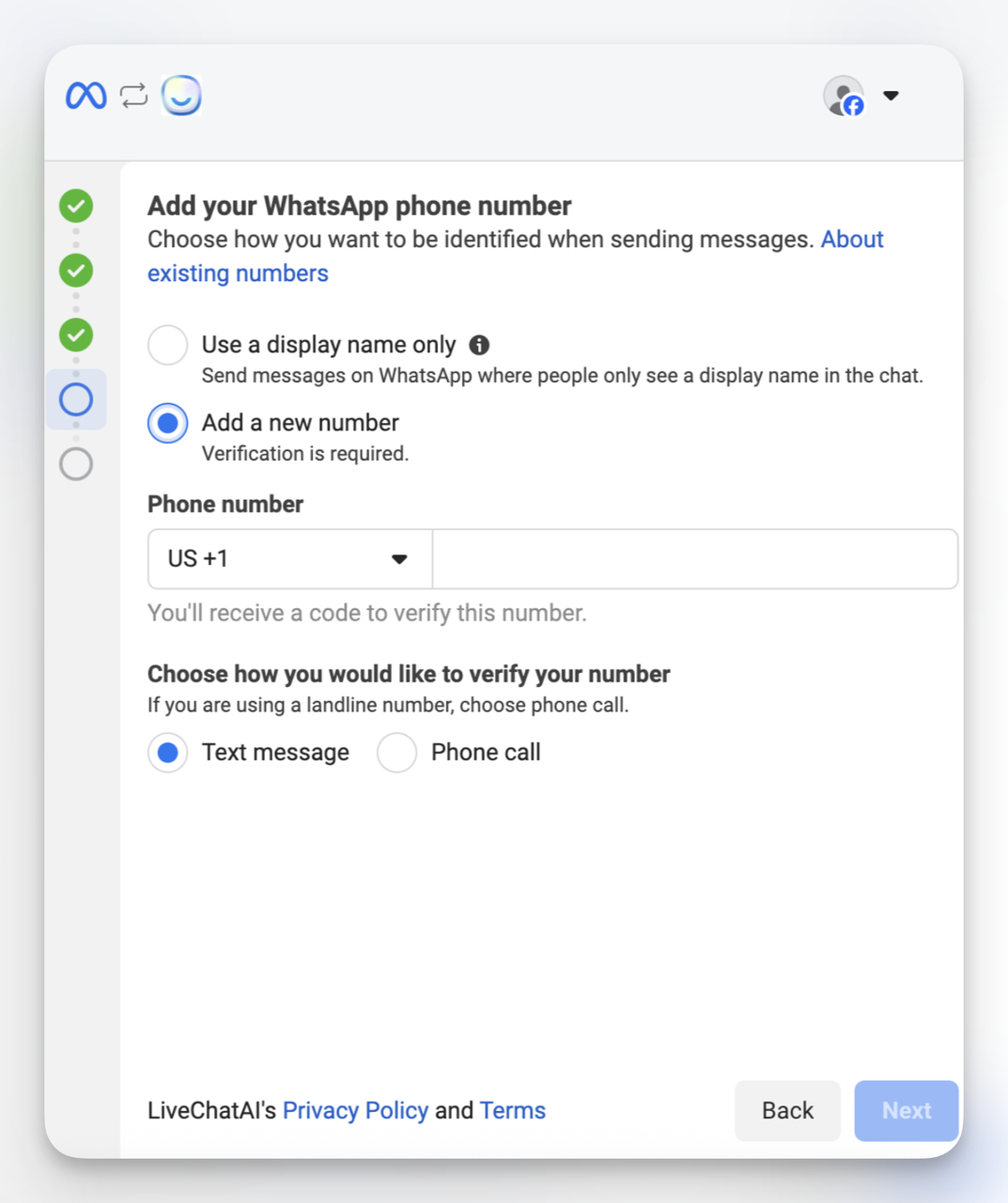
💬 In my experience: Using a dedicated number just for customer service keeps your automation clean and avoids conflicts with marketing or personal lines.
✅Finalize Connection and Confirm
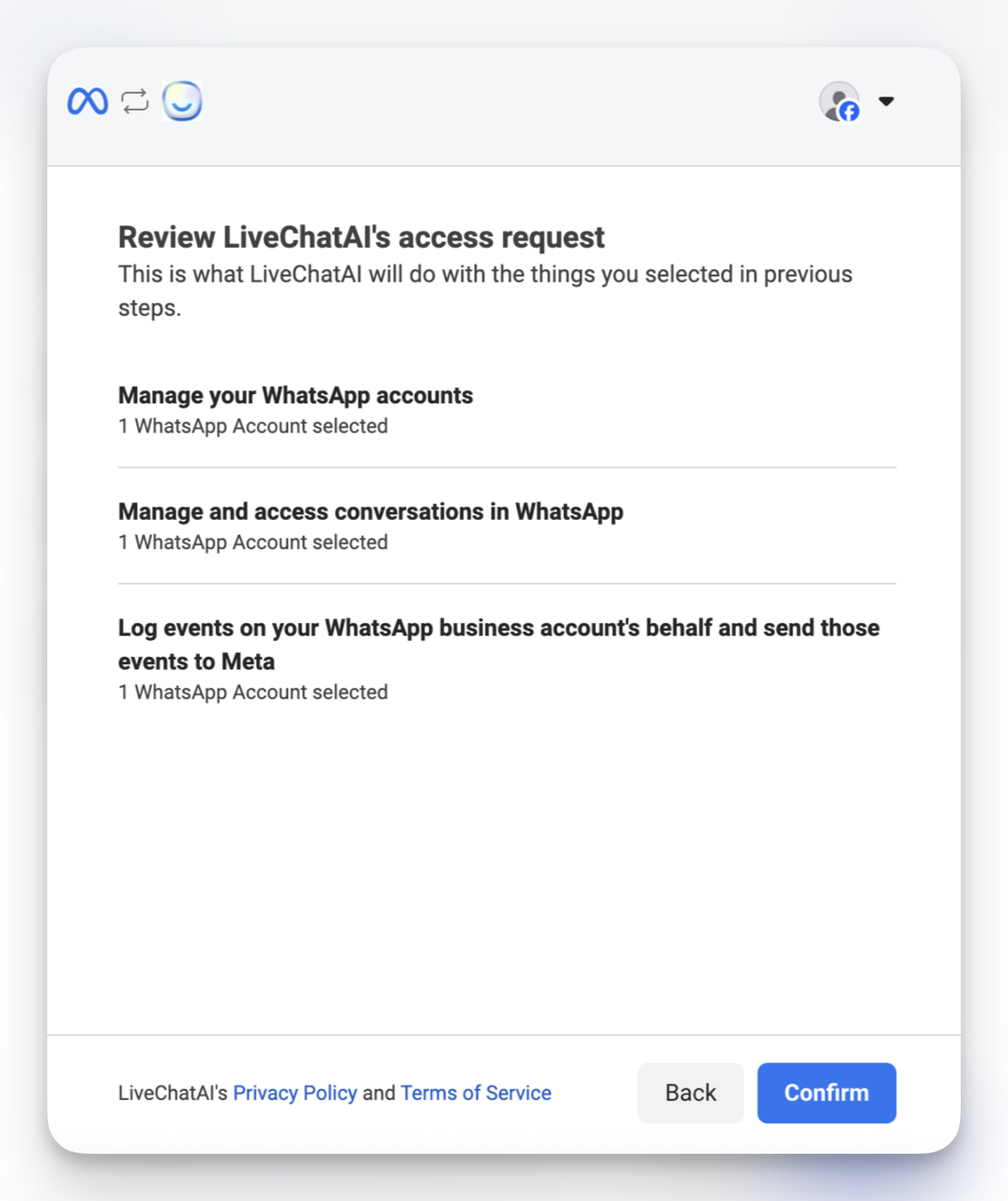
After verification, LiveChatAI will show the connected WhatsApp account along with its status = Active.
Here’s what I always double-check:
- The status indicator is green (active).
- The linked bot is the correct one (the one you trained for Shopify).
- The default message templates (like welcome and fallback) are enabled.
💡 Pro tip: You can also rename the integration (e.g., “Shopify Support Line”) so it’s easier to track if you manage multiple WhatsApp channels.
🧪Send Your First Test Message
Now comes the fun part 🎉
- Open WhatsApp on your phone.
- Send a message like “Hi, I have a question about my order” to your business number.
- Watch LiveChatAI automatically respond using your bot’s logic.
If you see the reply within a second or two, congrats — your Shopify AI chatbot is now officially live on WhatsApp.
💬 In my experience: This single connection changes everything. WhatsApp becomes not just a messaging channel but a sales and support layer powered by your Shopify data. Customers can check products, ask questions, and even get order info without leaving WhatsApp.
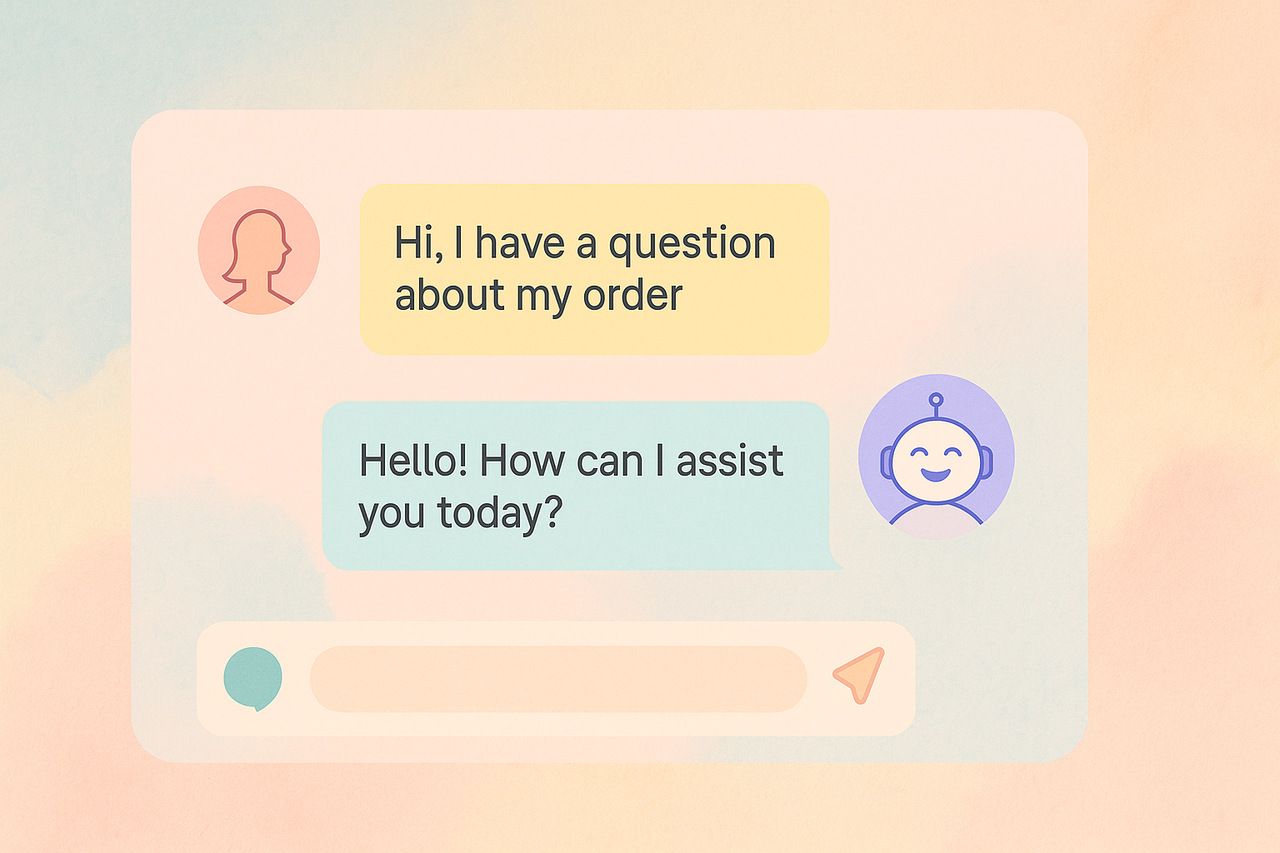
🧠 Train the Bot with Shopify & FAQ Content
Now that your Shopify store and WhatsApp are connected through LiveChatAI, it’s time to give your chatbot a brain — the training data.
In my experience, this step is where most people either make or break their chatbot experience. If you train it properly with clear, structured data, you’ll get sharp, human-like replies. If you skip it, you’ll end up with vague, generic answers. Let’s do it right.
📚Add Product, Return, Shipping & Policy Content
Your goal here is to make sure the chatbot has access to every piece of customer-facing knowledge that lives in your store.
In the LiveChatAI dashboard:
- Go to Sources → Add New Source
- Choose Shopify, URL, PDF, or Manual Text Upload (depending on where your content lives).
- Import your Shopify FAQs, return policy pages, shipping details, and product data.
💡 Pro tip: I always include short summaries for each section (e.g., “Returns must be requested within 14 days”) — this helps the model answer faster and more precisely.
🧩Use AI Suggestions to Improve Accuracy
Once your content is added, open the Training tab. You’ll see AI Suggestions — LiveChatAI automatically highlights areas where your bot might not have enough data or clarity.
Here’s how I use it:
- If the system says “Add examples for refund timeframes,” I go and add specific customer Q&A.
- I also test tricky queries like “Do you ship internationally?” or “How can I exchange a damaged product?” to see how the bot responds.
If answers are off, I refine my content — sometimes just rephrasing one sentence in the FAQ fixes multiple related questions.
🏷️ Write Better Prompts & Example Messages
In my experience, giving your chatbot strong starter messages makes a huge difference — both in how customers engage and in how accurate the bot becomes.
Here are a few templates I personally use for Shopify + WhatsApp bots:
💬 Pro tip: Keep WhatsApp responses short and conversational. Two to three sentences max. I always use emojis sparingly (✨, 🛍️, ✅) to humanize replies without making them look spammy.
💡 In my experience: Once your content is properly connected and refined with AI Suggestions, the chatbot starts feeling alive — it can reference real products, recall your policies, and maintain consistent tone across channels.
🛒 Key Shopify AI Actions for WhatsApp Support
By this point, your chatbot is connected, trained, and ready to interact — but the real magic happens when you activate specific Shopify AI Actions inside LiveChatAI.
These AI Actions are what make the bot “do things,” not just talk. In my experience, once you enable the right mix, you’ll notice your chatbot start to feel like an actual virtual assistant — pulling live product info, updating carts, and recalling store policies on the fly.
🔎Product Lookup & Recommendations
The first (and most used) action is search_shop_catalog. It’s the core of your product discovery automation.
💬 Example queries customers might send on WhatsApp:
- “Do you have leather belts under $30?”
- “Show me black sneakers in size 42.”
- “I’m looking for a cotton hoodie.”
Here’s what happens under the hood:
- The chatbot detects the intent (product search).
- It triggers search_shop_catalog to query your Shopify database.
- It then returns product results (with names, images, and prices) directly inside the WhatsApp chat.
💡 My tip: Keep product titles short in Shopify — long names clutter WhatsApp messages.
🧺Cart Review & Updates
The second most important one is get_cart and update_cart.
💬 Example messages:
- “Show my cart.”
- “Add the black T-shirt in size M.”
- “Remove the blue jeans.”
Here’s how I structure it:
- Use get_cart to show what’s currently inside.
- Use update_cart to add or remove items, and confirm the new total.
🧠 Pro tip: You can also use WhatsApp’s quick-reply buttons for “View Cart” or “Checkout” — this reduces friction and increases completion rates.
📜Policies & FAQ Automation
Support doesn’t stop at products — customers constantly ask about shipping, returns, and warranties.
That’s where search_shop_policies_and_faqs comes in.
💬 Example messages:
- “How long do returns take?”
- “Do you ship to Germany?”
- “What’s your refund policy?”
LiveChatAI retrieves the exact information from your store’s policies (or uploaded FAQ sources) and replies instantly.
💡 In my experience: Linking your policy pages as training sources AND enabling this action gives the most consistent results — otherwise, the bot may mix in generic language.
🧾Order Status & Automation
This is where things get advanced — but incredibly powerful.
You can automate order tracking and updates using Make, Zapier, or OpenAPI integrations.
💬 Example use case:
Customer: “Where’s my order #A1247?”
Chatbot → Fetches order status from Shopify → Replies with live update.
You can also set it to send follow-up messages like:
“Your package has shipped 🎉 Tracking link: [link].”
💬 In my experience: Once these four AI Actions are active, your WhatsApp chatbot becomes a full-fledged Shopify assistant — capable of answering 70–80% of support tickets automatically while increasing conversion opportunities.
🧑🤝🧑 Human Handoff & Live Chat Scenarios
Even the smartest Shopify WhatsApp chatbot can’t (and shouldn’t) handle everything.
In my experience, the key to great customer support isn’t replacing your agents — it’s amplifying them.
That’s why LiveChatAI’s human handoff system is one of my favorite features. It lets you route complex, emotional, or high-value customer interactions to real agents at just the right moment — without losing context or making the customer repeat themselves.
🧭 When to Trigger a Handoff
In practice, I set up handoff rules around three main triggers:
LiveChatAI lets you define these thresholds easily inside the Automation or AI Settings tab of your bot.
💡 Tip: Keep escalation rules tight — over-escalation defeats the purpose of automation, while under-escalation frustrates customers.
🧵Smooth Context Transfer (No Repeated Questions)
One thing I’ve learned the hard way: nothing kills a customer experience faster than being asked to “start over” after a handoff.
LiveChatAI solves this neatly by passing the full conversation transcript and detected intent to the agent interface.
So, when a human takes over, they instantly see:
- The full WhatsApp message thread
- What the customer asked and what the bot answered
- Detected product, order number, or category
That means your agents can jump straight into solving — not re-qualifying.
💬 In my experience: This feature alone can cut average resolution time by 25–30%, because agents no longer repeat the same questions the bot already covered.
🕘After-Hours Routing Best Practices
If you’re running 24/7 WhatsApp support, after-hours handoffs need structure.
Here’s how I handle it:
- Set an after-hours auto-message:
“Hey 👋 We’re currently offline, but I’ve logged your message. Our human team will get back to you at 9 AM tomorrow.” - Allow the bot to handle simple requests (like FAQs or product lookups) even when agents are offline.
- Tag late-night conversations for the morning queue so your team can prioritize them first thing.
This hybrid flow keeps your store “awake” while giving your team a healthy work rhythm.
💡 In my experience: Customers don’t expect humans 24/7 — they expect help 24/7. By blending instant bot support with well-timed human handoff, you’ll deliver both efficiency and empathy, which is the perfect balance for Shopify support.
🧪 QA Checklist Before Launch
Before you go live with your Shopify WhatsApp Support Chatbot, I always recommend running a full end-to-end quality assurance test.
In my experience, even the most technically perfect setup can fall short if you skip this step — sometimes a single wrong permission or outdated FAQ entry can break the entire customer experience.
Here’s the checklist I personally use before I push any chatbot live for clients 👇
🧩 Test Product & Variant Queries
Make sure your Shopify catalog connects seamlessly with LiveChatAI.
I always test a few specific query types:
💡 Pro tip: Test at least 3–4 product categories to confirm indexing. If something doesn’t appear, re-sync the catalog from the Shopify AI Action panel.
📦 Verify Policy & Return Answers
Since policy questions make up nearly 40% of eCommerce support tickets (source: HubSpot Service Trends 2025), I always double-check this part.
Try these queries:
- “What’s your refund window?”
- “Do you offer free shipping?”
- “How do I return an item from abroad?”
If the answers come back vague or inconsistent, review your policy data sources in the Training → Sources tab and ensure the correct URL or FAQ is linked.
🧑💻Simulate Handoffs & Review Transcripts
I always test at least one human handoff manually.
You can simulate this by sending a message the bot isn’t trained for — like:
“My product arrived damaged, and the size is wrong.”
The bot should detect confusion or frustration and escalate the chat to an agent, carrying the full context with it.
Afterward, check the transcript inside LiveChatAI → Conversations to verify:
- The entire chat history transferred
- The agent could reply seamlessly
- No duplicate responses were sent
💡 In my experience: A single clean handoff test prevents a lot of headaches later, especially if you use WhatsApp for VIP or post-purchase support.
📱Test Across Devices & Networks
Finally, I test the chatbot as if I were a real customer — on different devices, networks, and time zones.
I always check:
- ✅ Android vs. iPhone layout in WhatsApp
- ✅ Wi-Fi and mobile data responsiveness
- ✅ Image and product card rendering
- ✅ Link previews (for Shopify product pages)
💡 Tip: Keep your test group small but diverse. A 10-minute internal test with teammates often catches formatting issues you might overlook alone.
💬 In my experience: A well-tested bot gives customers confidence from the very first message. Once you tick everything off this checklist, your WhatsApp chatbot will be ready to serve, sell, and scale — without a hitch.
💵 Cost & Plan Notes (My Personal Advice)
When I help brands set up Shopify WhatsApp chatbots, I always tell them — this integration pays for itself fast if implemented right.
Here’s how I think about it 👇
- AI support ≈ 30–50% cost reduction on repetitive inquiries (order status, shipping, returns).
- Source: Zendesk CX Trends 2025
- LiveChatAI pricing: typically scales with active chats and integrations. If you’re running one Shopify store and one WhatsApp channel, the entry tier usually covers it.
- WhatsApp Business Platform: Meta charges per conversation, not per message — rates vary slightly by country (see Meta pricing).
- ROI checkpoint: once your chatbot deflects ~25% of tickets or boosts WhatsApp conversions by ~5–10%, it’s paying for itself.
💡 My short take: Start small, measure deflection rate, then upgrade your LiveChatAI plan when you see consistent automation wins — not before.
🏁 Conclusion
When I first connected Shopify, WhatsApp, and LiveChatAI together, I realized I wasn’t just building a chatbot — I was building a support system that sells.
In my experience, once your customers get used to asking product or order questions right inside WhatsApp and getting instant, accurate replies, there’s no going back.
It’s faster, more personal, and it makes your brand feel present — even when your team is offline.
To recap briefly:
- You connected Shopify via AI Actions so your bot can access live product and policy data.
- You linked WhatsApp Business to LiveChatAI, verified your number, and tested your first message.
- You trained your bot with FAQs, policies, and products.
- And finally, you enabled AI Actions for real-time product search, cart updates, and policy lookup — giving customers instant answers.
💬 The result: a fully functional Shopify WhatsApp Support Chatbot that can handle up to 70–80% of support requests automatically (based on LiveChatAI’s 2025 user data).
If you haven’t already, you can start setting this up directly from:
👉 https://www.livechatai.com
💡 My Final Advice
Start simple — one bot, one WhatsApp number, one Shopify store.
Then track three things over the first month:
- 🧠 Deflection rate (what % the bot handles alone)
- ⏱️ Response time improvement
- 💵 Conversions from WhatsApp chat sessions
Once you see consistent results, scale it. Add multiple languages, connect more stores, and let AI Actions do the heavy lifting.
❓ Frequently Asked Questions (FAQ)
1. Do I need coding experience to set up the chatbot?
Nope! LiveChatAI’s Shopify and WhatsApp integrations are 100% no-code. You’ll just follow prompts to connect your store and verify your number.
2. Can I use my personal WhatsApp number for this setup?
Not recommended. You should use a WhatsApp Business Account connected to your Meta Business Manager, as personal numbers can’t support automation or templates.
3. How long does setup usually take?
If your accounts are verified, it usually takes under 30 minutes to connect both Shopify and WhatsApp — plus another 15–20 minutes for training content.
4. Can I track conversations or agent performance?
Yes. Inside LiveChatAI’s dashboard, you can view full chat transcripts, tag intents, monitor agent replies, and measure automation success rates.
5. Is this compliant with WhatsApp’s policies?
Absolutely. LiveChatAI uses Meta’s official WhatsApp Business API, meaning all opt-ins, templates, and privacy standards align with Meta’s rules.
✅ That’s a wrap! You now know how to create, train, and launch your own Shopify WhatsApp Support Chatbot — powered by LiveChatAI.
Check out these blog posts as well:
- How to Create an AI Agent for Customer Support (2025)
- Best Open Source ChatGPT Alternatives: A Helpful Guide
- Create Your First AI Chatbot With Your Support Content
- Does ChatGPT Save Data? Yes. Here's How to Control It
- 35 Live Chat Greeting Examples to Increase Interaction




